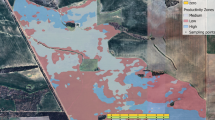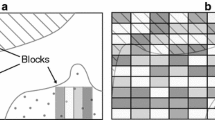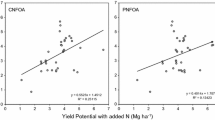Abstract
Methods are available to predict nitrogen needs of winter wheat based on plant sensing, but adoption rates by producers are low. Current algorithms that provide nitrogen recommendations based on plant sensing implicitly assume that parameters are estimated without error. A Bayesian updating method was developed that can incorporate precision plant sensing information and is simple enough that it could be computed on-the-go. The method can consider producers prior information and can account for parameter uncertainty. Bayesian updating gives higher nitrogen recommendations than plant sensing recommendations using a plug-in method. These recommendations increase net returns over the previous recommendations, but not enough to make plant sensing profitable in this scenario.


Similar content being viewed by others
Notes
Note that this practice is an expected profit maximizing strategy since in some years, the nitrogen will be needed. The marginal revenue of applying nitrogen in years that it is needed is roughly 6–10 times its marginal cost and thus it pays to apply nitrogen that is only needed once every 6–10 years.
The algorithm to apply a different amount to each square meter is adjusted to apply little or no fertilizer to areas of the field with little plant growth and so it may be more beneficial than the model used here. It also has a nonlinear yield function rather than a linear function. The commercial algorithm also applies more nitrogen.
Note that the current commercial implementation of NFOA recognizes that the plug-in approach leads to under-application of N. To correct this problem, current models use a lower value of β 1 in order to get closer to the optimal level. Since the NFOA assumes no error, no application cost and the β 1 is high enough that it pays to apply nitrogen, the optimal solution with NFOA does not depend on prices.
References
Alchanatis, V., Scmilovitch, Z., & Meron, M. (2005). In-field assessment of single leaf nitrogen status by spectral reflectance measurement. Precision Agriculture, 6, 25–39.
Babcock, B. A. (1992). The effects of uncertainty on optimal nitrogen applications. Review of Agricultural Economics, 14, 271–280.
Baquet, A. E., Halter, A. N., & Conklin, F. S. (1976). The value of frost forecasting: A Bayesian appraisal. American Journal of Agricultural Economics, 58, 511–520.
Begiebing, S., Schneider, M., Bach, H., & Wagner, P. (2007). Assessment of in-field heterogeneity for determination of the economic potential of precision farming. In J. V. Stafford (Ed.), Proceedings of the 6th European conference on precision agriculture (pp. 811–818). Wageningen, The Netherlands: Wageningen Academic Publishers.
Biermacher, J. T., Brorsen, B. W., Epplin, F. M., Solie, J. B., & Raun, W. R. (2009). The economic potential of precision nitrogen application with wheat based on plant sensing. Agricultural Economics, 40, 397–407.
Boyer, C. N., Brorsen, B. W., Solie, J. B., & Raun, W. R. (2011). Profitability of variable rate nitrogen application in wheat production. Precision Agriculture, 12, 473–487. doi:10.1007/s11119-010-9190-5.
Boyer, C. N., Lambert, D. M., Velandia, M., English, B. C., Roberts, R. K., Larson, J. A., et al. (2016). Cotton producer awareness and participation in cost-sharing programs for precision nutrient-management technology. Journal of Agricultural and Resource Economics, 41, 81–96.
Boyer, C. N., Larson, J. A., Roberts, R. K., McClure, A. T., Tyler, D. D., & Zhou, V. (2013). Stochastic corn yield response functions to nitrogen for corn after corn, corn after cotton, and corn after soybeans. Journal of Agricultural and Applied Economics, 45(4), 669–681.
Bullock, D., & Mieno, T. (2017). An assessment of the value of information from on-farm field trials. Unpublished Working Paper, University of Illinois, Champaign, IL.
Bushong, J. T., Mullock, J. L., Miller, E. C., Raun, W. R., Klatt, A. R., & Arnall, D. B. (2016). Development of an in-season estimate of yield potential utilizing optical crop sensors and soil moisture data for winter wheat. Precision Agriculture, 17(4), 451–469.
Byerlee, D. R., & Anderson, J. R. (1982). Risk, utility and the value of information in farmer decision making. Review of Marketing and Agricultural Economics, 50, 231–246.
Doll, J. P. (1971). Obtaining preliminary Bayesian estimates of the value of a weather forecast. American Journal of Agricultural Economics, 53, 651–655.
Doye, D., Sahs, R., & Kletke, D. (2014). Oklahoma Farm and Ranch Custom Rates, 2013–2014. Stillwater, OK, USA: Oklahoma Cooperative Extension Service Fact Sheet CR-205 0214 Rev.
Duda, R. O., Hart, P. E., & Stork, D. G. (2001). Pattern classification. New York, NY, USA: Wiley.
Ehlert, D., Schmerler, J., & Voelker, U. (2004). Variable rate nitrogen fertilization of winter wheat based on a crop density sensor. Precision Agriculture, 5, 263–273.
El-Hout, N. M., & Blackmer, A. M. (1990). Nitrogen status of corn after alfalfa in 29 Iowa fields. Journal of Soil and Water Conservation, 45, 115–117.
Erickson, B., & Widmar, D. A. (2015). 2015 precision agricultural services dealership survey results. West Lafayette, IN, USA: Department of Agricultural Economics and Department of Agronomy, Purdue University. Retrieved September 14, 2016, from http://agribusiness.purdue.edu/files/resources/2015-crop-life-purdue-precision-dealer-survey.pdf.
Franzen, D., Kitchen, N., Holland, K., Schepers, J., & Raun, W. (2016). Algorithms for in-season nutrient management in cereals. Agronomy Journal, 108, 1775–1781.
Havránková, J., Rataj, V., Godwin, R. J., & Wood, G. A. (2007). The evaluation of ground based remote sensing systems for canopy nitrogen management in winter wheat—Economic efficiency. Agricultural Engineering International: The CIGR Ejournal. Manuscript CIOSTA 07 002, 9.
Huang, W., McBride, W., & Vasavada, U. (2009, March). Recent volatility in U.S. fertilizer prices causes and consequences. Amber Waves, pp. 28–31.
Krause, J. (2008). A Bayesian approach to German agricultural yield expectations. Agricultural Finance Review, 68, 9–23.
Large, E. C. (1954). Growth stages in cereals: Illustration of the Feekes Scale. Plant Pathology, 3(4), 128–129.
Marshall, G. R., Parton, K. A., & Hammer, G. L. (1996). Risk attitude, planting conditions and the value of seasonal forecasts to a dryland wheat grower. Australian Journal of Agricultural Economics, 40, 211–233.
McMaster, G. S., & Wilhelm, W. W. (1997). Growing degree-days: One equation, two interpretations. Agricultural and Forest Meteorology, 87(4), 291–300.
National Agricultural Statistics Service (NASS). (2017a). Wheat-price received, measured in $/BU. National. US Total 2013. Annual Marketing Year. Retrieved January 3, 2017, from https://quickstats.nass.usda.gov.
National Agricultural Statistics Service (NASS). (2017b). Price paid. Nitrogen, urea 44–46%—Price paid, measured in $/ton. National. US Total 2013. Retrieved January 3, 2017, from https://quickstats.nass.usda.gov.
Norwood, F. B., Lusk, J. L., & Brorsen, B. W. (2004). Model selection for discrete dependent variables: Better statistics for better steaks. Journal of Agricultural and Resource Economics, 29, 404–419.
Oklahoma State University. (2016a). Experiment 222: Long-term application of N, P, and K in continuous winter wheat, est. 1968. Retrieved June 28, 2016, from http://www.nue.okstate.edu/Long_Term_Experiments/E222.htm.
Oklahoma State University. (2016b). Experiment 502: Wheat grain yield response to nitrogen, phosphorus, and potassium fertilization. Lahoma, OK. Retrieved June 28, 2016, from http://nue.okstate.edu/Long_Term_Experiments/E502.htm.
Ouédraogo, F. B., Brorsen, B. W., & Arnall, D. B. (2016). Changing nitrogen levels in cotton. Journal of Cotton Science, 20, 18–25.
Pautsch, G. R., Babcock, B. A., & Breidt, F. J. (1999). Optimal information acquisition under a geostatistical model. Journal of Agricultural and Resource Economics, 24, 342–366.
Rajsic, P., & Weersink, A. (2008). Do farmers waste fertilizer? A comparison of ex post optimal nitrogen rates and ex ante recommendations by model, site, and year. Agricultural Systems, 97, 56–67.
Raun, W. R., Solie, J. B., Johnson, G. V., Stone, M. L., Mullen, R. W., Freeman, K. W., et al. (2002). Improving nitrogen use efficiency in cereal grain production with optical sensing and variable rate application. Agronomy Journal, 94, 815–820.
Raun, W. R., Solie, J. B., Stone, M. L., Martin, K. L., Freeman, K. W., Mullen, R. W., et al. (2005). Optical sensor-based algorithm for crop nitrogen fertilization. Communications in Soil Science and Plant Analysis, 36, 2759–2781.
Rodriguez, D. G. P., & Bullock, D. S. (2015). An empirical investigation of the Stanford’s “1.2 Rule” for nitrogen fertilizer recommendation. Selected Paper. San Francisco, CA, USA: Agricultural and Applied Economics Association.
Schimmelpfennig, D., & Ebel, R. (2016). Sequential adoption and cost savings from precision agriculture. Journal of Agricultural and Resource Economics, 41, 97–115.
Tembo, G., Brorsen, B. W., Epplin, F. M., & Tostão, E. (2008). Crop input response functions with stochastic plateaus. American Journal of Agricultural Economics, 90, 424–434.
Tumusiime, E., Brorsen, B. W., Mosali, J., Johnson, J., Locke, J., & Biermacher, J. T. (2011). Determining optimal levels of nitrogen fertilizer using random parameter models. Journal of Agricultural and Applied Economics, 43, 541–552.
Zellner, A. (1971). An introduction to Bayesian inference in econometrics. New York, NY, USA: Wiley.
Acknowledgements
The research was partially funded by the Oklahoma Agricultural Experiment Station and USDA National Institute of Food and Agriculture, Hatch Project number OKL02939.
Author information
Authors and Affiliations
Corresponding author
Rights and permissions
About this article
Cite this article
McFadden, B.R., Brorsen, B.W. & Raun, W.R. Nitrogen fertilizer recommendations based on plant sensing and Bayesian updating. Precision Agric 19, 79–92 (2018). https://doi.org/10.1007/s11119-017-9499-4
Published:
Issue Date:
DOI: https://doi.org/10.1007/s11119-017-9499-4




